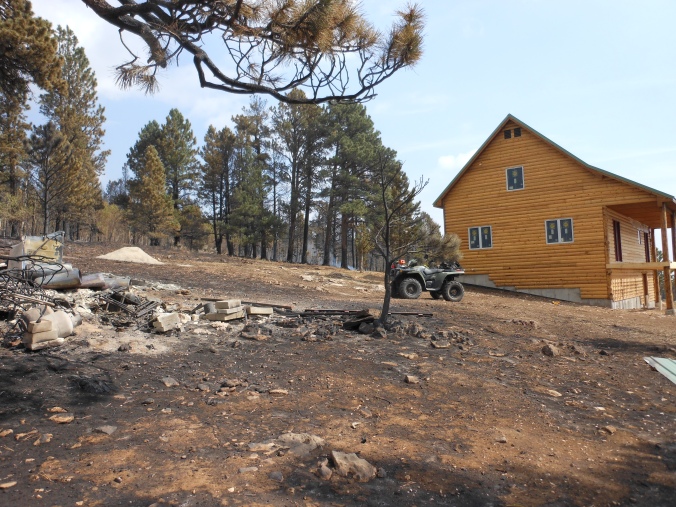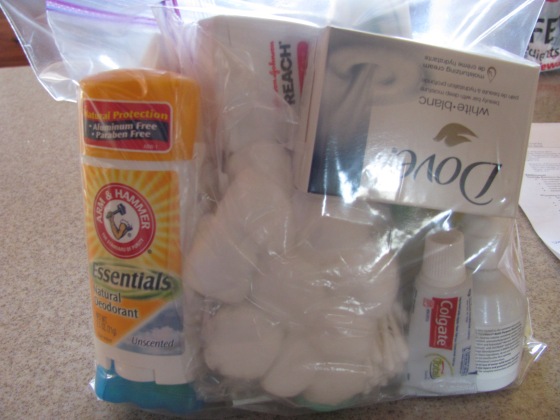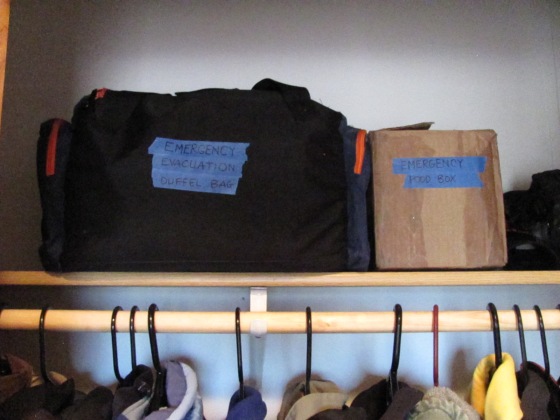My husband is an Eagle Scout and a wildland firefighter, so being prepared is a pretty big deal around here. Last year we bought a house at the foothills of the Rocky Mountains and the area surrounding our home is a combination of sagebrush and Rocky Mountain juniper. The juniper is very dense and often leaves very little soil moisture for much understory vegetation. Juniper is an excellent carrier of fire due to naturally occurring oils in the needles, even when the fuel moisture is high, and it is so dense around our house and the hillsides are so steep, it’s like living at the top of a chimney stacked high with tinder. If we ever had a fire, our whole subdivision would be obliterated. The other aspect of my husband’s job is to coordinate the FireWise program for all 23 counties in the state of Wyoming and manage the Federal grants program for fuels reduction in the state.
Last year we applied with our county to become a FireWise property for a number of reasons. 1) Always be prepared. 2) Each county has a coordinator to work with individual landowners to create a management plan to make their homes fire safe, or FireWise. The coordinator came to our house and worked with us to develop a plan for thinning the trees around the house to a safe distance and density to reduce the chance of our home burning in the event of a wildfire. Once we complete the work agreed to in the plan, we get monetarily reimbursed for time spent cutting trees and burning piles, and any direct costs are reimbursed. 3) Aside from being prepared in the event of a wildfire, when firefighters are working in the area they do what is called “structure triage.” Structure triage means they go from home to home in the area (if time and resources allow) and do what they can to prepare the house for fire in the area. This includes removing wood piles, deck furniture, and grills with propane tanks to a safe distance from the siding; cutting back vegetation from under the porches and next to the houses and scattering brush so it doesn’t linger after it burns. If a home has been prepared by the landowners, the firefighters will do what they can for the house and/or stay near the home (if safe and feasible) to help protect it. If the landowner has done no work to reduce fuel around the house, there is a good chance the firefighters won’t spend time preparing around the house if there is too much work to do, too much risk to the firefighters, or no chance to save the home. In addition to clearing trees from around the house, we also spent quite a lot of time along the driveway. Our driveway is kind of a hairy beast and ascends at a steep angle with a sharp hairpin turn in the middle of it. Firefighters will not risk their own safety to protect or prepare a house if they will be put at risk, so if the driveway has the potential to be a safety hazard (dense brush or trees, too narrow, no turn around, etc.) they won’t venture up. We spent some time widening the turn-around at the house, as well as removing brush on the sides of the driveway. Hopefully, none of this will ever be tested by a wildfire, but if it is, we want to give our house the best chance of surviving and encourage the men and women fighting the fire to do what they can to prevent our house from burning.
My husband left this afternoon for his first fire assignment of the season on the Lime Gulch fire outside of Colorado Springs. We were out of town and drove home this morning so he could leave for Colorado and on the drive we were talking about the event of an evacuation should a fire start near our house. The following is our family preparation and evacuation plan for 2013. For additional information and templates (some of which I have used myself) please visit Your Own Home Store: Survival Kit Ideas.
PREPARATION:
- Check attic and crawl space vents in house and garage – one of the main causes of homes burning is embers getting caught in the attic or under the house. Close crawl space/basement ventilation and check attic vents to determine if screen size is large enough to allow flying embers to enter the attic. Reducing the size of the screen or ventilation opening can prevent larger, hotter embers from becoming lodged in the attic and igniting the home.
- Remove propane tank from gas grill on the porch and store in garage when not in use
- Remove deck furniture pillows and umbrellas from the deck when not in use and store inside (garage, house, crawl space, etc.)
- Sign up for reverse 9-1-1 from the city or county. We live in a rural area, so the county sheriff’s department initiates the reverse 9-1-1 call. If you live in town, sign up through the police department
- Clear any bushes or plants from under the porch and along the house that are dead and dry. Keep any plants around the house well irrigated and properly pruned. This includes keeping grass short and green.
EVACUATION:
I have put together an evacuation plan and checklist should we need to evacuate. Every family will have a different list of important items, but the main idea is to know what needs to go, assign who gathers what, and have it written down. We have a coat closet next to the front door where I have staged our evacuation kit. On the upper shelf is a duffel bag which contains the following:
- Emergency First Aid and Toiletries Kit
- Emergency phone numbers and important information sheet
- 3 pairs boxers
- 3 pairs underwear
- 6 pairs socks
- 4 t-shirts
- 2 sweatshirts
- 2 pair jeans
- Zebra print ball cap (obviously identifying and hard to miss)
- Umbrella
- Day-Glo Orange emergency vest
- Towel
- Leather gloves
- 2 pair knit gloves
The sheet of emergency phone numbers and important information contains family phone numbers, vehicle registration and insurance policy information, health insurance information, doctors phone numbers, and phone numbers of friends nearby. It isn’t something you want to think about, but if your house burns down you’ll be contacting your insurance carrier to file a claim and need that information. Additionally, should someone be hurt or need medical attention, it’s good to have the medical information in more than just one location. I have also backed up this file on Dropbox – an online cloud-based data storage location that I can access from any computer or my phone. Another good online backup and document/note storage program is Evernote.
In the First Aid and Toiletries Kit I have packed the following:
- Ibuprofen
- Tylenol
- Sunscreen
- Band aids
- Hand sanitizer
- Neosporin
- Medical tape
- Wound dressing
- Pepto Bismol
- Dramamine
- Chapstick
- Bug repellent
- Shampoo/conditioner
- Soap
- Contact lens solution and cases
- Extra contacts for each of us, labeled
- Toothpaste
- Toothbrushes
- Tampons
- Dental floss
- Emergency heating pack
- Q-tips and cotton balls
- Emergency electrolyte powder
- Deoderant
- Extra prescription medication (if needed)
Next to the duffel bag of personal items is a box with non-perishable food and 4 gallons of water. All of this stays for the whole summer and doesn’t get raided for any event that isn’t the evacuation of our family due to wildfire or any other emergency.
I have also made two checklists for us of items to collect and pack should we get the call to evacuate. I made two lists – one in the event that we have 15 minutes or less and must leave RIGHT THIS MINUTE:
Ilana
- Three filing boxes
- Mortgage packet
- 2 external hard drives
- Computer with charging cable
- Wedding rings
- 4 Gallons water
- Food box
- Emergency duffel bag
- 2 pairs running shoes
- 2 pairs hiking boots
Nick
- Small dog crate from garage
- Dog duffel bag with medical records
- Dog leash
- Dog bed
- Dog food
- Wedding photo with signed frame
- Close windows and blinds
- Close interior doors in house
The Fremont County Sheriff’s Department has a great webpage detailing what to do to prepare your home before you evacuate. I have listed to close windows and blinds and interior doors, and here’s why: fire produces convective, radiant, and direct heat. Convective heat is the transfer of heat from rising hot air and gasses – this is what makes fire race up hill as vegetation is heated and dried out by heated air and gas and moisture is forced from the vegetation, making it receptive to burning. Drafts and wind can influence convective heat by drawing hot air, which is why closing the interior doors in the house is suggested. By closing interior doors, drafts inside the home are reduced. Radiant heat is heat released in all directions from an burning object – this is why you get warm sitting next to a camp fire and nearby fire can heat up the outside of your home or even heat furniture and draperies through windows. For the most part, it’s possible to reduce the effect of radiant heat inside the home by drawing blinds on all the windows. Finally, conduction is the process by which heat is transferred by direct contact. Removing flammable objects from directly touching the home during the preparation phase of Emergency Preparedness can reduce losses from heat conduction.
I also expanded the above list to include other items we might want to take if we have longer to pack – say one hour:
Ilana
- Three filing boxes
- Mortgage packet
- 2 external hard drives
- Computer with charging cable
- Wedding rings
- 4 Gallons water
- Food box
- Emergency duffel bag
- 2 pairs running shoes
- 2 pairs hiking boots
- Recipe boxes
- Grandpa’s Marine keepsake album
- Family quilts (1 from couch, 2 from cedar chest)
- Family pocket watch
- Diplomas
Nick
- Small dog crate from garage
- Dog duffel bag with medical records
- Dog leash
- Dog bed
- Dog food
- Wedding photo with signed frame
- Eagle Scout frame and mirror
- Special photographs
- Photo albums
- Family keepsakes
I listed the items by rank of importance with the idea that you go down the list and if you run out if time, you’ll have the most important things first. When we have some time I am planning to do a practice run through and time us as a team in collecting what needs to be gathered, as well as by myself since there’s a good chance I’ll be the only one home. Additionally, I have templates for emergency information, and for our dog. I created the dog ID page when we took her to be boarded since she has an annoying habit of escaping. The ID page includes a photograph of her, as well as her important information – physical description, AVID ID number, rabies ID number, vet contact information, our contact information, medical needs, etc. If you would like a copy of either of these templates, please leave me a comment and I can email them to you. This is also great for young kids should the unspeakable occur and your child become lost or kidnapped. Keep the photo up to date and take copies with you when you’re out of town.
This is the first time I’ve put the time and effort into this sort of emergency preparation. Natural catastrophes of any kind are scary as shit. There is so much anxiety and stress and fear running rampant in these situations and the best thing you can do is be prepared. I urge you to take the time (this took me 2 hours by myself) to make a list of important things, put them somewhere accessible, and print out a few lists. Even if you only consolidate your essential documents into one place that you can grab as you leave in an evacuation will make your life so much easier. Mother nature will have her way whether or not you’re ready, so take a few minutes to make a list; plan an afternoon with your family and make sure everyone knows the drill, what to take, and where to meet.
Every region has natural disasters and summer is ours. Please pray for the firefighters and families affected by the fires in Colorado, Arizona, New Mexico, and California. I know tornado season and hurricane season are either already here or fast approaching. Think about where you live and what you will need to take with you to keep yourselves safe.
For more information about FireWise programs in your area, please visit their web page at http://www.firewise.org/ for information about making your home and community a FireWise community. They have great resources for homeowners. Wyoming State Forestry recently published a great series of articles in cooperation with the University of Wyoming called Living with Wildfire in Wyoming. Additionally, you can contact your State Forestry agency for more information on cost share and funding for fuels mitigation in your area.



I just got a briefing that I need a “go bag” before we move overseas, just in case we have to be evacuated. I love your idea of having a lists based on how much time you have to get out! I’m definitely stealing that idea. I can see myself spending the first 15 minutes of the hour deciding what to take!
LikeLike
Thanks for the great article. Well said.
LikeLike
Ilana, great post with some very extensive and helpful information. As you know, I LOVE the idea of plans based on time, but yours are more extensive than mine. I admire all that you are doing to be prepared. And thanks for the link to my site as well!
LikeLike